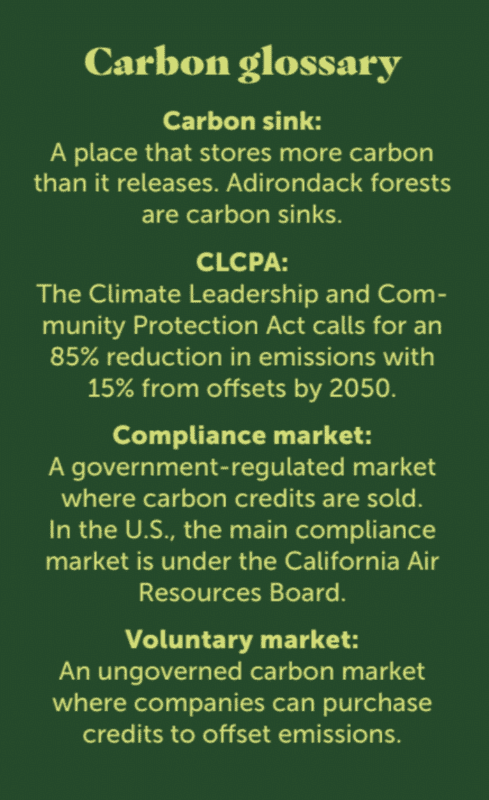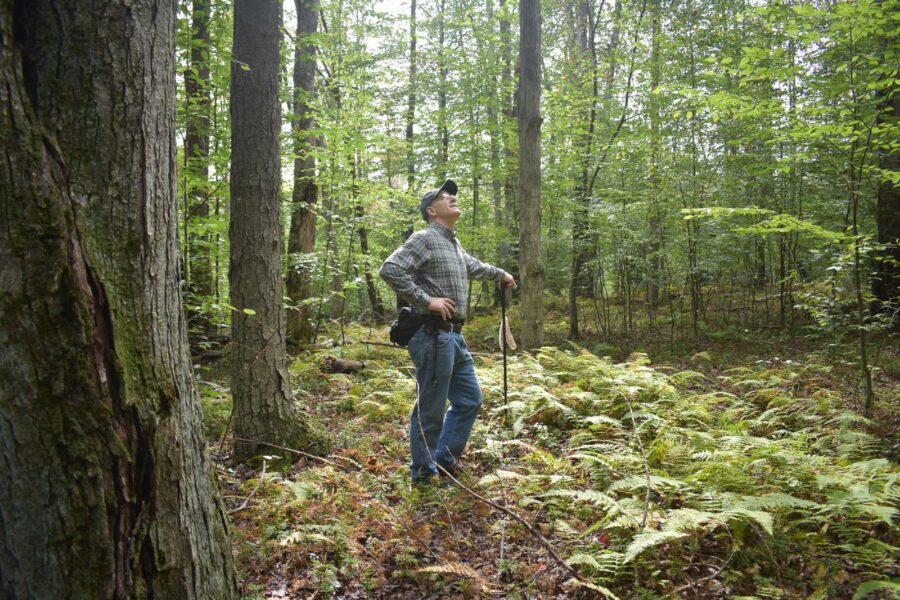Plus: How organizations within the park are speaking with the billion-dollar sector
By Chloe Bennett
Hundreds of numerous woody acres within the Adirondacks grow to be a part of the thriving carbon credit score historical past market and attracting world financiers.
As companies search to counteract their contamination and New York intends to counter its discharges, unique North Country timber confirm helpful to traders and buyers of carbon credits.
The Adirondack Explorer many thanks its promoting and advertising and marketing companions. Become one of them.
The Adirondack Park’s substantial woodland carbon sink has really soaked up contamination for ages. Now, elements of the timberlands are important players in a worldwide enterprise: Trees proceed maintaining undesirable greenhouse gases nevertheless are leveraged by contaminating companies spending for the woodlands’ preservation.
The technique acquired attraction in latest occasions as a momentary service to the surplus amount of co2 and varied different greenhouse gases warming the earth. Landowners, generally wooden companies within the park’s occasion, register their property in a balanced out program that intends to help woodlands hold much more carbon than they would definitely with out the job.
Carbon credit score scores are stemmed from the estimation of additional carbon space for storing.


Some Adirondack- based mostly duties generate credit score scores marketed on the conformity market, which is managed by the California federal authorities. Other duties are volunteer and ungoverned by state or authorities entities. Companies with sustainability or atmosphere goals should buy credit score scores willingly and promote the monetary funding to clients.
The Adirondack Explorer many thanks its promoting and advertising and marketing companions. Become one of them.
A deal beforehand this yr of 92,200 acres unfold across the park recommends an increase in world charge of curiosity secretive North Country timbers.
In February, a brand-new wooden monetary funding monitoring firm, Eastwood Forests, launched its very first acquisition remained within the space. Powered by a worldwide fund, the enterprise took management of stewardship of the Upper Hudson Woodlands, presently referred to as Northway, with tales in a lot of Adirondack Park areas.
The Northway constructing has really an present balanced out association agented by Finite Carbon, an efficient visibility in North American carbon credit score historical past markets. As part of the land buy, Eastwood Forests will definitely proceed with the carbon balanced out program that’s presently in place.
Carbon credit score scores are created by defending a bulk of the land and dealing with in between 2,000 and 4,000 acres yearly by amassing timber or executing varied different kinds of forestry, a speaker for the enterprise acknowledged.
The Adirondack Explorer many thanks its promoting and advertising and marketing companions. Become one of them.
Eastwood Forests contains foresters with expertise within the park and companions from Tokyo- based mostly Sumitomo Forestry.The enterprise is headquartered in Chapel Hill, North Carolina.
By 2027, Eastwood Forests intends to deal with round 320,000 acres of North American forests with help from $415 million elevated from Japan- based mostly financiers, the companions launched. The Northway property and constructing in Virginia and West Virginia had been the very first 2 purchases.
Matt Sampson, vice head of state of woodland monitoring for Eastwood Forests, acknowledged expertise with the Adirondacks’ ambiance and with the state Department of Environmental Conservation (DEC) had been amongst the components behind the acquisition.
“It was fortunate that the Northway property was among the first acquisition opportunities for Eastwood Forests,” he acknowledged. “Our team has decades of experience with the complexities of management in the Adirondack region.”
The Adirondack Explorer many thanks its promoting and advertising and marketing companions. Become one of them.

About 83,000 acres are registered within the job, which was licensed proper right into a 100-year dedication below the California- based mostly conformity market. The very same woodland is secured below a steady state preservation easement, with smaller sized methods protected by easements with the Open Space Institute and The Nature Conservancy.
Widespread monetary investments within the park
A testimonial of public data reveals the carbon market’s monetary funding within the Adirondacks covers a minimal of 428,000 acres, regarding 7% of the park, with appreciable holdings operating below the park’s greatest landowner since 2014,The Molpus Woodlands Group Other entities related to the park’s carbon applications include The Forestland Group, Park Forestry, The Northeast Wilderness Trust andBluesource
The timber that comprise the land can withdraw co2 for hundreds of years and proceed a number of of the space for storing as timber objects. Scientists and foresters have really lengthy acknowledged the scientific analysis, nevertheless some presently study the strategies of out of doors entities getting cash from the all-natural atmosphere service.
Corporations consisting of Disney, Microsoft and airline firms take credit score historical past for saving woodlands by buying the worldwide carbon balanced out market, valued at $948 billion in 2023, based on the London Stock Exchange Group.
By together with the timber to their profiles, companies declare to fight contamination from their journeys, constructions and varied different procedures through carbon space for storing. Terms like “carbon neutral” and “net zero” are utilized by companies and federal governments to elucidate the career, as woodland carbon balanced out duties intend to cancel discharges, not take away them.
Eastwood Forests and Sumitomo Forestry established an goal to maintain an added 1 million a lot of carbon in North American woodlands yearly by exercising lasting forestry, that features atmosphere preservation and a few wooden harvesting. The amount quantities what seems of larger than 200,000 gas-powered cars pushed for a yr.
The inspiration behind buying the Adirondacks was to increase capitalist profiles, Sampson acknowledged.
Offset designer Finite Carbon, which is presently had by oil and fuel titan BP, lags a variety of the brazenly provided promote the park and markets carbon credit score scores to companies aiming to counteract their contamination.
Finite presently has really 60 balanced out duties in American woodlands, consisting of a minimal of 5 within the 6-million-acre Adirondack Park, finishing larger than 370,000 acres.

Walking removed from {the marketplace}
Four years again, The Nature Conservancy and Paul Smith’s College managers checked out the capability for the school to create carbon credit score scores from a number of of its 14,000-acre woodland. The supply might need sustained the Adirondacks’ simply four-year college economically all through a time of flip over and a considerable scarcity displayed in tax obligation data. Profit from carbon duties differs generally by land and program, although landowners can get hold of numerous bucks a yr.
But the college ignored the possibility. In 2021, a brand-new head forester for the college puzzled concerning the efficiency of a carbon balanced out job on college and the school was frightened regarding shedding versatility with woodland monitoring.
A dedication to reducing greenhouse fuel discharges through its procedures and forestry didn’t line up with the job, acknowledged John Foppert, trainer and head forester for the college.
To Foppert, providing carbon credit score scores would definitely be irregular with the college’s ecological necessities. “I gave voice to my concerns that this would be taking some of the work that our forests do to make the world a better place and importing a bunch of emissions that belonged to other companies elsewhere in the economy, but that were going into the same global atmosphere that we all live under,” he acknowledged.
Foppert is amongst a number of foresters and researchers questioning concerning the efficiency of carbon balanced out applications and markets. Studies consisting of a 2021 collaboration with schools in California and not-for-profit Carbon Strategy revealed 29% of conformity duties overstated carbon space for storing benefits. The vary of the error was “enormous,” Carbon Strategy composed, finishing $410 million over credit score scores.
A recent analysis from balanced out rating agency Renoster and Carbon Strategy revealed 3 Finite Carbon duties within the united state had little or no atmosphere benefits. Around 79% of credit score scores should not have really been launched, a report appointed by The Guardian revealed. None of the duties had been based mostly within the Adirondacks.
Restoring the state’s carbon sink
Although the DEC is alerted of carbon duties knotted in easements, it doesn’t monitor the financiers’ ventures as a result of the marketplaces are uncontrolled by the state.
Yet, New York has enthusiastic atmosphere methods that include countering contamination through its woodlands. The state Climate Leadership and Community Protection Act of 2019 ask for decreasing 15% of greenhouse fuel discharges through offsets, supplementing an goal of reducing discharges by 85% of 1990 levels.
The DEC in latest occasions has really launched carbon balanced out sources for landowners and this springtime signed up with a dialogue along with an organization straight related to balanced out presents.
In May, reps from the SUNY College of Environmental Science and Forestry (ESF), The Nature Conservancy and the DEC supplied their explicit take care of carbon space for storing within the state on the Adirondack Research Consortium inLake Placid
Molly Hassett, a DEC forester with the division of lands and woodlands, acknowledged the division is focused on acquiring atmosphere discount strategies in place like lasting woodland monitoring and taking full benefit of carbon space for storing. Using a brand-new machine from ESF that may monitor land utilization adjustment, Hassett acknowledged the state may decide the place logging and carbon loss are occurring.
New York’s woodland carbon sink is decreasing, acknowledged Colin Beier, affiliate trainer at ESF and bait the carbon machine. “It has been weakening largely (due) to deforestation. Not a problem here in the Adirondack Park, but a problem elsewhere in the state,” he acknowledged.
One service for saving tiny tales of land is with carbon stability out presents, based onThe Nature Conservancy
“The Nature Conservancy has spent a lot of time in the last couple of years working on global standards to be able to provide the benefits from the carbon market,” acknowledged Michelle Brown, the conservancy’s aged preservation researcher in New York, all through the consortium event. “We need to make sure we’re doing good projects.”
Recognizing imperfections in its very personal duties, the corporate created a varied carbon audit technique, acknowledged Kevin Maddaford, supervisor of united state and Canada carbon markets for TNC. Projects are supplied an additional standard normal to remain away from overemphasizing the amount of carbon saved. An inside testimonial process was likewise broadened, he acknowledged.
Brown acknowledged atmosphere discount is a key emphasis of the decades-old preservation firm. Shifting focus removed from the intricacies of carbon markets and balanced out applications, she acknowledged the strategy is solely one part of the Adirondacks’ assortment of all-natural atmosphere strategies. The extensive benefits of North Country woodlands are what appeal to her in as a researcher, she acknowledged.
“These lands, particularly, these forest lands have recreational values, aesthetic values, clean air, clean water, wood products, wildlife, connectivity,” she acknowledged. “Truly, that co-benefit space is definitely the spark for me.”
Photo at prime: Paul Smith’s College’s woodland has really been thought-about for a carbon job. Photo by Brendan Wiltse

